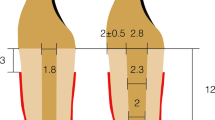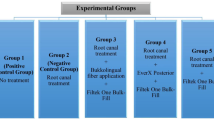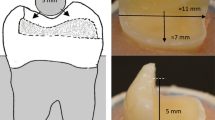Abstract
Fracture of interim fixed partial dentures (FPD) is of important concern to the dental surgeon, especially with long-span fixed partial dentures or areas of heavy occlusal stress. Polymers used in interim FPDs, reinforced with glass fibers have shown to have a positive effect on the fracture resistance of interim FPDs. Since little research has been done on the influence of silane treated glass fibers on the fracture resistance of interim FPDs, this study was conducted to evaluate the effect of silane treatment of glass fibers on the fracture resistance of interim FPDs and its correlation with the position of fiber reinforcement and length of the span of the interim FPD. Interim FPDs were fabricated from an autopolymerizing polymethyl methacrylate (PMMA) resin. Seven FPDs were made in each group. The FPDs in the control group were unreinforced, and in the other groups the FPDs were reinforced either with non silane treated glass fiber or with silane treated glass fiber. The fibers were placed in two different locations in the FPDs. Three length of span of FPDs were tested. The load was applied to the FPD by a steel ball placed in the center of the pontic space. One Way Anova, Two Way Anova, Studentized range test (Scheffe’s). Results showed that the load required for fracturing the unreinforced FPDs varied from 272 to 998 N. Mean fracture load of reinforced FPDs varied from 536 to 1642 N. One-way analysis of variance showed that the position of fibers and the silane treatment fibers significantly affected the fracture load. The results of this study suggested that the silane treatment of glass fibers had a marked improvement in the fracture resistance of FPDs as compared to untreated glass fibers. Selective placement of the glass fibers at the undersurface of the pontic and the occlusal surface of the interim fixed partial denture showed more increase in the fracture resistance as compared to the randomly distributed glass fibers. The glass fiber reinforcement is effective in increasing the fracture resistance with the effectiveness most evident in interim FPDs with long spans. With increase in the length of span of interim fixed partial denture the fracture resistance was shown to decrease significantly in all the groups.











Similar content being viewed by others
References
Nohrstrom TJ, Vallittu PK, Yli-Urpo A (2000) The effect of placement and quantity of glass fibers on the fracture resistance of interim fixed partial dentures. Int J Prosthodont 13(1):72–78
Vallittu PK (1995) A review of methods used to reinforce polymethyl methacrylate resin. J Prosthodont 4:183–187
Stipho HD (1998) Effect of glass fiber reinforcement on some mechanical properties of autopolymerizing polymethyl methacrylate. J Prosthet Dent 79:580–584
Vallittu PK (1998) Some aspects of the tensile strength of unidirectional glass fibre-polymethyl methacrylate composite used in dentures. J Oral Rehabil 25:100–105
Vallittu PK (1998) The effect of glass fiber reinforcement on the fracture resistance of a provisional fixed partial denture. J Prosthet Dent 79:125–130
Vallittu PK (1993) Comparison of two different silane compounds used for improving adhesion between fibres and acrylic denture base material. J Oral Rehabil 20(5):533–539
Solnit GS (1991) The effect of methyl methacrylate reinforcement with silane-treated and untreated glass fibers. J Prothet Dent 66:310–314
Hamza TA, Rosenstiel SF, El-Hosary MM, Ibraheem RM (2006) Fracture resistance of fiber-reinforced PMMA interim fixed partial dentures. J Prosthodont 15(4):223–228
Vallittu PK (1997) Curing of a silane coupling agent and its effect on the transverse strength of autopolymerizing polymethyl methacrylate-glass fiber composite. J Oral Rehabil 24:124–130
Vallittu PK (1998) Compositional and weave pattern of glass fibers in dental polymer fiber composites. J Prosthodont 7:170–176
Vallittu PK (2000) Effect of 180-week water storage on the flexural properties of E-glass and silica fiber acrylic resin composite. Int J Prosthodont 13:334–339
Gutteridge DL (1992) Reinforcement of poly(methyl methacrylate) with ultrahigh-modulus polyethylene fiber. J Dent 20:50–54
Powell DB, Nicholls JI, Yuodelis RA, Strygler H (1994) A comparison of wire-and Kevlar-reinforced provisional restorations. Int J Prosthodont 7(1):81–88
Conflict of interest
None.
Author information
Authors and Affiliations
Corresponding author
Rights and permissions
About this article
Cite this article
Basant, G., Reddy, Y.G. The Effect of Incorporation, Orientation and Silane Treatment of Glass Fibers on the Fracture Resistance of Interim Fixed Partial Dentures. J Indian Prosthodont Soc 11, 45–51 (2011). https://doi.org/10.1007/s13191-011-0059-8
Received:
Accepted:
Published:
Issue Date:
DOI: https://doi.org/10.1007/s13191-011-0059-8




